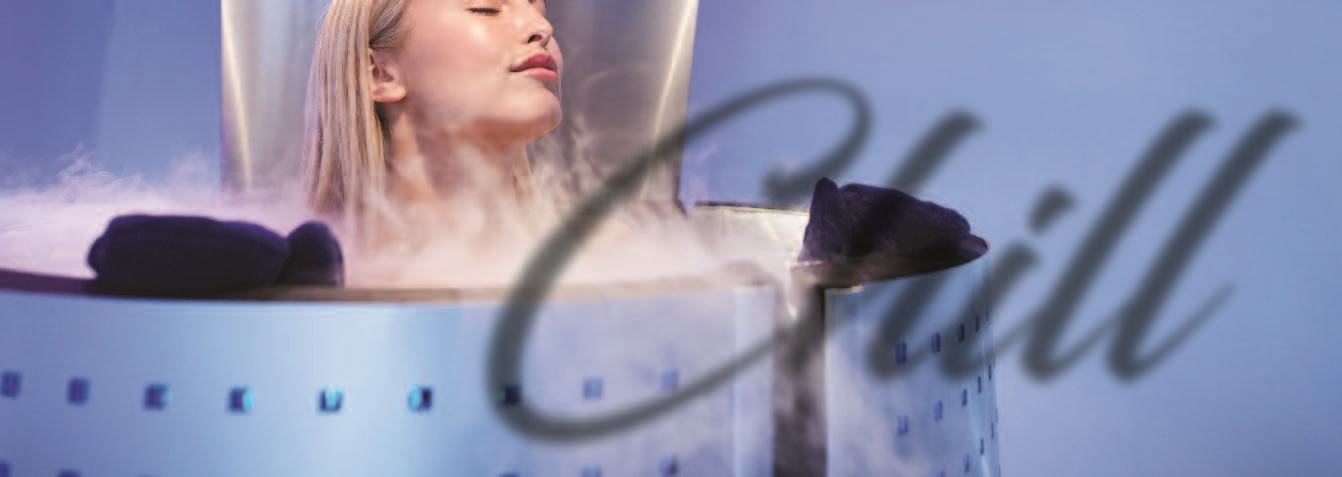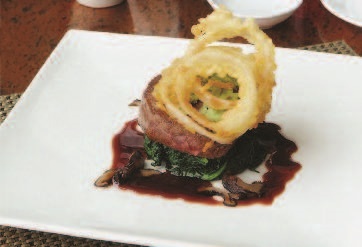 ELIZABETHTOWN GAS REPRESENTATIVES ADDED HOLIDAY HAPPINESS AND JOY TO BROTHER BONAVENTURE RESIDENTS
ELIZABETHTOWN GAS REPRESENTATIVES ADDED HOLIDAY HAPPINESS AND JOY TO BROTHER BONAVENTURE RESIDENTS
Thank you to the representatives from Elizabethtown Gas who visited the residents at Brother Bonaventure Long Term Care Facility recently. They personally delivered blankets and holiday cards to every resident, sang holiday songs along with them, and even helped celebrate a birthday! Not only did everyone love the warm and cozy blankets but many new friendships were made!
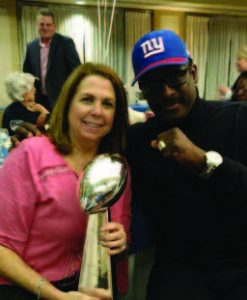 TAILGATE WITH TRINITAS RAISES OVER $31,000
TAILGATE WITH TRINITAS RAISES OVER $31,000
On Sunday, December 3, 2017, guests gathered at Shacka-maxon Country Club in Scotch Plains to watch the New York Giants take on the Oakland Raiders. NY Giants greats Ottis Anderson, Stephen Baker and Bill Neill delighted Trinitas supporters. While the Giants did not walk away with a win, Trinitas took home a win by raising over $31,000 in net proceeds! Thank you to everyone who supported this year’s Tailgate with Trinitas event; you are the real MVPs! Pictured above is Stephen Baker “The Touchdown Maker” and Lisa Liss, Trinitas Director of Volunteers having fun together.
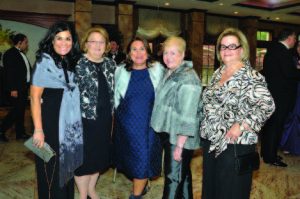 SAVE THE DATE AND JOIN US FOR TRINITAS HEALTH FOUNDATION’S 2018 ANNUAL GALA
SAVE THE DATE AND JOIN US FOR TRINITAS HEALTH FOUNDATION’S 2018 ANNUAL GALA
This year the event will be held on Thursday, May 10th at The Venetian in Garfield, New Jersey. Join us for a fun-filled night with dinner and dancing to music performed by The Infernos. You’ll also have a chance to win some amazing prizes by participating in our raffle drawing, tricky tray, and silent & live auction.
Please join us as we present the Healthcare Foundation of NJ with the Humanitarian Award and Allscripts with the Celebrating Philanthropy Award. Both organizations are very worthy of recognition.
Can’t join us but still want to support Trinitas? Contact the Foundation to learn about the many different sponsorship opportunities available, our online advertisement journal and other ways you can participate by donating items to our tricky tray and silent/live auction.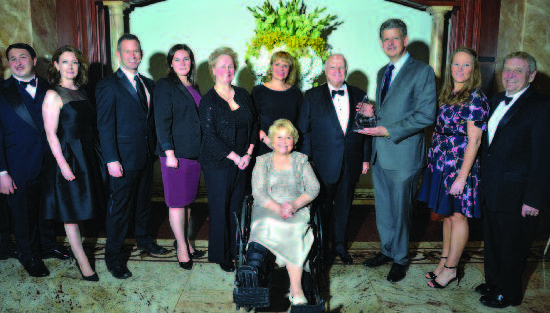
For more information contact Kim Boyer, Director of Fundraising Events, at (908) 994-8249 or kboyer@trinitas.org.
 Trinitas celebrated Heart Month with a fashion show and heart talk, “Paint the Town: Go Red for Women” in February at Lord & Taylor in Westfield, where women learned about heart disease and had fun in the process.
Trinitas celebrated Heart Month with a fashion show and heart talk, “Paint the Town: Go Red for Women” in February at Lord & Taylor in Westfield, where women learned about heart disease and had fun in the process.

Trinitas literally went
red during the month!
Heart Month and National Wear Red Day were celebrated in style at Trinitas in a number of ways. At the start of the month, Elizabeth Mayor Chris Bollwage proclaimed National Wear Red Day at a special presentation in the Trinitas lobby. Dr. Mirette Habib addressed 40 women on heart health during a “Going Red for Women” event held at Lord & Taylor in Westfield. 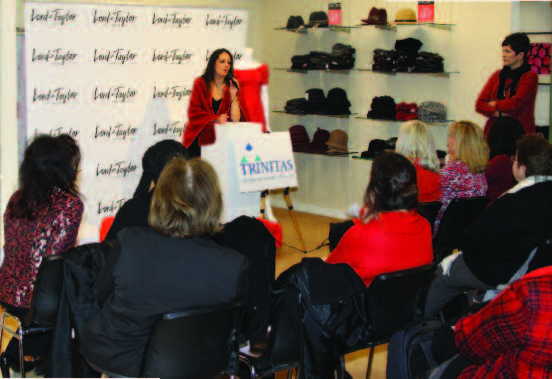
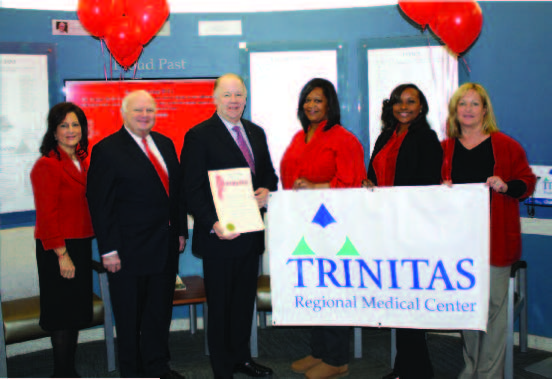
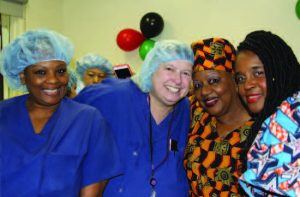 FOOD FOR THOUGHT
FOOD FOR THOUGHT
In February, Gwen Hassell (in orange and black) organized a Black History Month celebration feast for the Trinitas Operating Room staff. Gwen is joined by (left to right) Corssette Pratt, Joan Richard and Cathy Gittens.
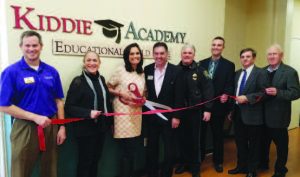 AMAZING STARTS HERE
AMAZING STARTS HERE
Kiddie Academy of Springfield, an educational childcare center, is open and enrolling new families. A brand new, state of the art facility with highly trained teachers and Life Essentials curriculum, the academy creates the opportunity for children to become truly amazing. They recently held their Grand Opening and ribbon-cutting ceremony which was accompanied by Jeff Pleis, Kiddie Academy Corporate, Nancy Kovacs, Director, Aanal Parikh, Owner, Mike Scalera, Chamber Co-Chair, Springfield Police Captain Pat McLaughlin and Lieutenant Jon Rachel, Chamber Co-Chair Scott Seidel and Chamber VP Elliot Merkin.
 SKY’S THE LIMIT
SKY’S THE LIMIT
State and local dignitaries joined the management team of Sky Zone to celebrate the opening of its 35,000 square feet indoor aerial action park on Route 22 in Springfield. The facility offers trampoline courts, a warped wall, “Skyslam” slam dunking, an Ultimate Dodgeball Court and a Foam Zone. Left to right for the ribbon cutting are Elliott Merkin of the Chamber of Commerce, Township Committeeman Chris Capodice, Sky Zone GM Rich Niemczyk, State Senator Tom Kean, Springfield Mayor Rich Huber, franchise owner Mike Janay, Operations Manager Keith Wilhelmy, and Chamber of Commerce Co-Chair Mike Scalera.
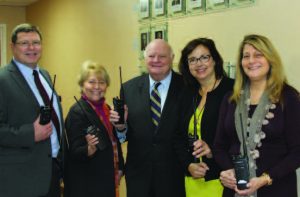 WE HEAR YOU NOW
WE HEAR YOU NOW
Thank you, Phillips 66 Bayway Refinery for the donation of five new Motorola APX 6000 portable radios for the Trinitas Mobile Intensive Care Unit (MICU).
The donation was celebrated by (left to right): Gerard Muench, Director of Pre-Hospital Services at Trinitas; Nadine Brechner, Vice President/Trinitas Health Foundation, Chief Development Officer; Gary S. Horan, FACHE, Trinitas President & CEO; Nancy Sadlon, Public Affairs Manager, Phillips 66 Bayway Refinery, and Mary Phillips, Community Relations Coordinator for the Refinery.
 EVENING AT THE RACES
EVENING AT THE RACES
On Saturday, February 17, 2018, more than 180 guests gathered at the Meadowlands Racetrack in East Rutherford to place their bets with Trinitas! Thanks to their support and the support of our amazing sponsors, we raised more than$72,000—the most money this event has garnered in more than seven years!
A special thank you goes out to everyone who attended and/or supported the event. You helped us make our first fundraising event of 2018 a huge success. To those in the know, Trinitas is always a sure bet! Pictured: Michael Klein, Arlene Horan, Jill Sawers (Foundation Board Chair), Gary Horan (President & CEO of Trinitas Regional Medical Center).
 SEEING IS BELIVING
SEEING IS BELIVING
Team Martucci is gearing up to participate in the Saturday, April 14th VisionWalk in New York’s Central Park. The event supports research for the treatment and prevention of retinal degenerative diseases. Among the many NJ supporters of the team is the Hilton Garden Inn in Springfield. For more information visit FightingBlindness.org.
“DaPesca brings honor to New Jersey’s fishes and fishing industry and fills a void in fine dining…created by restaurateurs and chefs who have failed to place local fishes on a proper pedestal.”
By Andy Clurfeld
Set back from the main drag of Morristown is the old Vail Mansion, a formidable structure that could, and once did, house any number of governmental offices in this, the county seat of Morris. Instead, it is home to four distinctive eating-and drinking entities that have, under its reinvention as Jockey Hollow Bar & Kitchen, become the dining-out headquarters in north-of-the-Raritan New Jersey for the tuned-in, private jet, chef’s-on-a-night-off, wine geek and raw-bar-loving sets. Translation: It’s the high-style crowd’s home away from home.
Christopher Cannon, late of the New York City restaurant scene, where he won James Beard Awards for Marea and L’Impero, came to New Jersey by way of marriage. Becky, his wife, grew up in North Jersey and knew it was ready for a visionary. Chris Cannon is a visionary.

Photos by AJ Sankofa/Courtesy of dePesca
For a time, Cannon was a visionary without a place to practice his progressive restaurant ways. A bitter divorce from his New York restaurant partners left him without dining rooms and bars to pour the artisan, quirky, impossible-to-find wines he was known for—and without a constant stream of fans looking to partake in the latest “Cannonball” blind wine-tastings. So the Cannons and their kids moved to Becky’s home state, and Chris Cannon started looking around for the perfect place to create a public space. Hey, why not a circa-1917 mansion on South Street in Morristown? What might intimidate most only inspires an industry veteran who appears to live by the motto, “If something’s easy, how can it be fun?”
Three years ago, Jockey Hollow became The Oyster Bar, which rocks nearly nonstop with pristine raw fishes, charcuterie, and plates small and large; The Vail Bar, a speakeasy-style hideaway where the go-getters and the glamorous convene over cocktails and fine fare; the Rathskeller, the basement beer hall-private events space that used to serve as Morristown’s very own jail and now hauls ‘em in for live music and top-tier craft brews to wash down German grub; and, upstairs, a somehow-intimate 70-seat fine-dining space.

Photos by AJ Sankofa/Courtesy of dePesca
You can explore the bars at your leisure. Right now, we’re talking about that upstairs restaurant-within-a-restaurant that the father of reinvention himself reimagined this winter as DaPesca.
DaPesca brings honor to New Jersey’s fishes and fishing industry and fills a void in fine dining that, inexplicably, in our state bordered by 130 miles of ocean, not to mention rivers and bays and myriad and many lakes has been created by restaurateurs and chefs who have failed to place local fishes on a proper pedestal. Cannon was bothered by this. Having recently acquired a chef as formidable as the mansion turned- restaurant itself—Craig Polignano, ex-Ryland Inn, among other high-end restaurants—to take charge of all things food at Jockey Hollow, and having developed an association with Eric Morris, founder and owner of Local 130, the New Jersey seafood specialist, Cannon was ready to shame the gun-shy of the Garden State. DaPesca does just that.
Sourcing primarily from Local 130, as well as Forty North Oysters, the Barnegat Oyster Collective and Sona-Far Hills Seafood, DaPesca names on its ever-changing menus the boats and their captains who fish off our coastlines and make possible what Polignano and his kitchen crew create.

Photos by AJ Sankofa/Courtesy of dePesca
If you eat at DaPesca regularly, captains such as Jim Lovgren and Eric Myklebust might become your guidestars for how to order.
There really is no better way.
For the Barnegat clams, sparked by a wispy ring of Calabrian chile, and the local oysters, with their slurpy salinity and ping of minerality, pave the way to a Spanish mackerel crudo set atop a tangle of cucumber strands spliced with puffed rice and scented with the penetrating power of yuzu. That intense citrus tames the mackerel, probably my favorite fish on the planet, and infuses the toasty puffed rice scattered about with unexpected freshness. The dish shows how inspiration can take hold. You’ll find the calamari á la plancha a revelation, especially if you’ve been eating the same-old, same-old renditions for a generation or so. Here, the local stuff isn’t fried and sent out to pasture with tomato sauce, but given an Asian twist with tamarind and noodles of papaya, Balinese peppers, and peanuts that act as so much more than a give-away garnish. I learned something new about calamari’s versatility in every bite. Our local tuna, too, took a spiritual trip to the Far East when Polignano chose to plate it in a pho-style broth scented with Thai basil and popping with crunchy sprouted mung beans. Polignano and Cannon readily admit pledging allegiance to the flag of Italy, culinary religion in New Jersey, after all. Which brings us to the pasta-risotto portion of the menu: Don’t pass by the “little hats” of pasta—cappellacci stuffed with nuggets of braised pork—that are set in a rich shellfish broth with little clams spurting big juices. Those curious counterpoints to the clam-pork duet? Beech mushrooms. They sop it all up. Meanwhile, the pinched logs of dostalini stuffed with the buttery-tangy Piedmontese cheese castelrosso take to a saucy combo of orange and puntarella, a hopped-up chicory, along with a side crumble of pistachios; and the risotto is positively daring, what with crab dancing with almost-sweet Meyer lemon and a verdant, rough chop of seaweed pesto working pine nuts not ground into the mix, but left whole and therefore more forceful. You know skate wing, right? Well, be prepared for something completely different here, as Polignano turns it on its ear. It’s twirled into something that looks like a mini muffin and partnered not just with the classic caper-butter duo, but with an Italianate twist of roasted cauliflower and grapes. This silky-textured, mild fish always tastes ever so slightly nutty to me. Well, darned if the chef doesn’t give his skate a flourish of hazelnuts at the finish. Bingo. Dayboat scallops are done simply and right here, with a slaw-like base of celery root and apple, cubes of potato and mysterious notes of black truffle that appear when least expected. The best lobster dish I’ve ever had in New Jersey is Polignano’s butter-poached lobster, which yins against the yang of translucent curls of fennel and threads of tarragon. But it’s the frothy bouillabaisse cream that did me in: How boffo is the rich-on-rich marriage of lobster and shellfish bubbles?

Photos by AJ Sankofa/Courtesy of dePesca
Not everything at DaPesca is divinity of the sea. I don’t get the need to wrap monkfish in prosciutto like the minions do, especially when sidemen include olives and sausage that only add to the oversalted taste of the dish. I also hope the squid ink gnocchi, with more squid on the plate, is nixed by now since it was mushy in texture and muddy of flavor. Desserts, too, need work: I’m not a fan of oversize anything, but the two cubes of lackluster carrot cake with a two-bite torpedo of mascarpone ice cream ain’t worth $4, let alone $14, and the trio of sorbets—blood orange, cranberry, and Meyer lemon—had awkward shards of ice within.
Next time, I’ll nab another round of the butter-poached lobster and see if I can get an extra bowl of that bouillabaisse froth. I’ll bring fish-shunners to sit at my table so I can order extras of the calamari and skate and mackerel and dive into their plates without competition. I’ve been looking for a big-ticket seafood joint like this for decades. DaPesca is where my odyssey ends.
NEW JERSEY’S BEST WINE LIST?
Chris Cannon may be over-the-moon about Jersey’s fishes, a fanatic about forging relationships with Garden State farmers and fascinated with the history of his newly adopted state, but there’s nothing more he loves than wine. Unless it’s the collection of eyeglass frames he’s amassed with a fervor that could be described as manic. But that’s a story for another issue of Edge. Cannon has the most idiosyncratically desirable wine list I know, a list that you’re given to scan on an iPad as you are seated, but really deserves a conducted class by itself on a day when Jockey Hollow is otherwise closed. Think a library-style, hushed opportunity to sit and read, and re-read a list that seems like it cannot be real. But it’s a list he’s been working on most of his adult life, establishing connections with importers, distributors, and winemakers, forging relationships with wine names major and utterly obscure. Frankly, Cannon’s tastes tilt to the obscure.
But his prices lean friendly. The centerpiece of his wine program is an evolving, always-changing list of “60 Under $60.” It’s a treasure trove of wines you never thought you’d be able to try, of grapes you’ve never heard of from winemaking regions that have no beaten paths, of styles that will teach you how to pair wine with food once and for all. Cannon and his floor crew love talking wine at the table with their guests, and they love sharing their latest finds. If you’re so inclined, give a call to arrange a “Cannonball” wine adventure, in which the wine maestro himself will pour—blind—wines largely from this “60 Under $60” list and guide you through the tasting. The Cannonball experience takes place on Fridays.
No matter where you dine at Jockey Hollow, you can take advantage of New Jersey’s best wine list.
DaPesca
At Jockey Hollow Bar & Kitchen • 110 South Street, Morristown • Phone: (973) 644.3180
Reservations accepted and recommended; major credit cards. Open for dinner Tuesday and Wednesday from 5 to 9 p.m., Thursday from 5 to 9:30 p.m., Friday and Saturday from5 to 10:30 p.m. A four-course tasting menu is $86, while a seasonal six-course tasting to be ordered by the entire table is $116. (With wine pairings, the six-course menu is $190.)
A la carte service is available at DaPesca except on Saturdays when only the tasting menus are served. For more information, visit www.jockeyhollowbarandkitchen.com.
Four innovations that will transform the way you live a decade from now.
By Luke Sacher
Two generations ago, yesterday’s vision of the future was showcased at the New York World’s Fair, Expo 67 and Walt Disney’s Tomorrowland. It was all about big things, produced by venerable Dow Jones conglomerates: moon rockets from Grumman and Lockheed/Martin, jumbo jets from Boeing, prefabricated housing made of “miracle materials” from Monsanto and DuPont,

www.istockphoto.com
monorails from AMF, communications satellites from Bell Laboratories, copying machines from Xerox. Today, a used smartphone has more processing power than all of NASA’s computers combined had for the moon landings; a lowly iPhone 6 is 32,600 times faster than the Apollo-era IBM Model 360, which was as big as a car.
The iPhone just celebrated its 10th birthday silver-lined only a handful of technical wizards and scholastic futurists dared to predict the impact that mobile supercomputers would have on the lives of billions, and only a few got it right. Smartphones have forever changed the way we interact with our material world, and with one another. Answers to questions simple and complex are now always at our fingertips. If you have Siri or Alexa, you don’t even need to use your fingers. One could say that we’ve become simultaneously smarter and dumber, but for better or worse, the fact is that the world will never go back to what it was a decade ago.
So what’s coming down the pike right now that holds the same game-changing potential? Here are four of the most promising new inventions, clouds that truly seem to be 100 percent silver-lined.

www.istockphoto.com
MEMORIES STICK
DNA STORAGE
In 1965, Gordon Moore, co-founder of Fairchild Semiconductor and Intel, predicted that the number of transistors that could be printed onto microprocessor chips would double every year, and chip performance/speed would double every 18 months. His prediction became known as “Moore’s Law.” What Moore may not have foreseen is that every five years, the amount of digital data worldwide increases roughly tenfold. Microprocessor chips and most data storage devices are made of silicon, hence the name Silicon Valley. Computers store and process data on silicon chips as binary digits (zeros and ones) via tiny electrical charges. The problem is that the physical limit of microchips as a medium for data storage and processing is fast being reached. Which means that instead of computers getting smaller and smaller, they will soon have to get bigger and bigger to manage all that data. Engineers and manufacturers simply can’t squeeze any more circuits onto microchips beyond a gap of a few atoms, and so can no longer build them fast and dense enough to keep pace with demand.

www.istockphoto.com
So what’s the alternative? Leonardo DaVinci said that the best solutions to most scientific problems were to be found in Nature and, in this case, it turns out he may have been right on the money. Over billions of years of biological evolution, Nature has generated the most advanced information storage medium currently known: DNA.“Oh, sure,” you’re saying, “I already know that DNA holds all the genetic data for building every living thing on Earth, but what can it do for me?” How about everything from saving your vacation photos to curing cancer?
The theory of storing digital data in DNA was conceptualized decades ago, but recent progress in applied biophysical technology is making it both possible and practical, perhaps sooner than anyone might think. DNA is much denser than silicon/nonorganic based media. The data for hundreds of thousands of DVDs (hundreds of terabytes) could fit on a thumbnail-sized quantity of DNA. It is also much more durable and, as we know, lasts virtually indefinitely. In comparison, nonorganic media may last only years or decades, and their formats and connection standards become obsolete even faster. DNA? Nope.
Traditional media such as hard drives, thumb drives and DVDs store data as sequences of binary code (0s and 1s) by modulating their electromagnetic and optical properties. DNA molecules store data as sequences of four component molecules called nucleotides: adenine, cytosine, thymine and guanine (A, C, T and G). The trick is to translate binary code to the quaternary code of DNA: 00 = A, 01 = C, 10 = T and 11 = G. For example, let’s say that a JPEG file’s first eight bits are 01111000. Break them into pairs (01 11 10 00), and translate those pairs to C-G-T-A. After determining what order the letters should go in, series of DNA strands are synthesized letter by letter, using an apparatus that takes bottles of As, Cs, Gs and Ts and mixes them in a liquid solution with “control” chemicals, which direct the reactions for their sequencing. By default, the process yields a secondary benefit of DNA storage: backup copies. Rather than making one strand at a time, it makes many identical strands at once before proceeding to the next strand in the series. Once the DNA strands are created, they must be protected against damage by drying them out and sealing them in containers that keep them cold and block water and light.
Perhaps the greatest advantage of DNA over electronic circuits is that it can interact with a biochemical environment like the human body. Computing with molecules involves recognizing the presence (or absence) of certain molecules, so a natural application of DNA computing is in the realm of bio-sensing and delivering medicines inside living organisms. DNA programs have already been put to medical uses, including diagnosing tuberculosis. Ehud Shapiro of the Weizmann Institute of Science in Israel has proposed a “nano-biological doctor in the cell” that targets cancer molecules. DNA can also be used to control motion, which introduces the possibility of creating DNA-based “nano-robots” to carry and deliver molecular cargo (therapeutic drugs) to precise disease targets inside humans. Remember the 1960s movie Fantastic Voyage? Imagine a miniaturized submarine made of DNA and Raquel Welch as a therapeutic drug!
DNA computation has enormous future potential. Its huge storage capacity, low energy cost, ease of manufacturing (which exploits the power of self-assembly and affinity with the natural world) are a gateway to nanoscale computing, using designs incorporating both molecular and electronic components. There remain many challenges to be addressed for the technology to move forward, but almost 100 years of traditional computer science techniques that have revolutionized silicon circuit design are now being applied to DNA-based computing. Progress so far has been steady and rapid. Onward and Inward!
GOING UP?
SIDEWAYS ELEVATORS
Over the past 50 years, many of the advanced fictional technological devices featured in the original Star Trek television series have been born into reality—flip phones, flat-panel video displays, and voice-activated computers to name three. Now add another one to the list: the Turbo Lift.
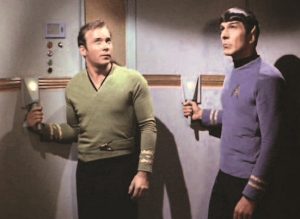
Paramount Television/CBS Television Distribution
German industrial and engineering conglomerate ThyssenKrupp (the same Krupp that forged the steel and built the armaments that turned Europe into a mass grave moonscape twice in the 20th Century) has created the MULTI, the world’s first vertical/horizontal elevator system. This past October, ThyssenKrupp premiered a fully functional “proof of concept” MULTI in its 800-foot test tower in Rottweil, Germany. The test tower has horizontal shafts only at its top and bottom, but OVG Real Estate’s East Side Tower in Berlin has contracted with the company to be the first actual building to install a complete “lattice grid” MULTI system later this year. The MULTI uses MAGLEV (magnetic levitation) propulsion technology, and “exchangers” at junctions of its X and Y axis tracks
“When we decided to take this type of exchanger, which was one in about twenty different concepts,” explains Markus Jetter, ThyssenKrupp’s head of product development for systems and components, “we found that this would also allow not only the change from vertical to horizontal but also to maybe any other angle in between.”
Conventional elevators are raised and lowered on counterweighted cables. They’re not very efficient. A lot of energy is used lifting the cables. MULTI is more energy-efficient than traditional cable/counterweight systems and, by running multiple cabins moving in a “loop” at up to 15 feet per second, the system can carry 50 percent more people—while also reducing wait times to between 15 and 30 seconds.
“Old School” elevators can only move along the Y-axis, and under the Newtonian Laws of fluid mechanics/inertia, can only rise to about 1,650 feet (500 meters). Sky-scrapers taller than that require multiple elevators and shafts, sometimes stacked on top of each other, in order to reach from the ground to top floors. The MULTI system’s “cable-free” design eliminates shaft height limits, releasing that constraint in skyscraper designs and allowing for far taller buildings to be economically feasible.
Shafts of cable elevators also take up a significant share of building floor space—as much as 40 percent in large skyscrapers. MULTI elevator cabins use common X and Y-axis shafts, thus significantly increasing a building’s occupied area. Their shafts are also roughly half the size of cable elevator shafts, which translates to more room for developers to install even more elevators. The MULTI design not only substantially increases the amount of occupancy space in single buildings, it could revolutionize metropolitan infrastructure and transportation, both for passengers and freight, since its elevators could travel between buildings, and not just up and down one. This is an architect’s dream come true
Might it be time to start thinking about preparing our farewells to taxicabs and subways and maybe even sidewalks?

Photo Courtesy of Toto
GAME OF THRONES
THE SMART TOILET
I suppose it makes perfect sense that Japan, the most hygiene-obsessed and robot-friendly nation on earth—with a swelling population of senior citizens—would also be the leader in “Smart
Toilet” research and development. The world’s largest toilet manufacturer, Toto, has partnered with medical technology company Daiwa to create Flowsky.
Flowsky is fitted with a sensor that measures a user’s urine flow-rate and volume, while a tiny self-cleaning receptacle inside the bowl is used to collect 5cc of urine for comprehensive measurement of glucose, albumin and hormone concentrations, as well as detection of inflammation indicators like leucocytes and antibody proteins. Blood pressure, heart rate, weight and body mass index (BMI) are recorded via a blood pressure monitor located within arm’s reach of the toilet and a floor scale in front of the basin. Data is then sent by a built-in smartphone to the user’s primary care physician.
Flowsky is presently only available in Japan, and only in medical facilities, but most likely not for much longer. Nursing homes in Japan are filled to capacity, and the number of older people is increasing rapidly. Flowsky promises to reduce skyrocketing medical costs, as well as eliminate the laborious and time-consuming standard procedure of acquiring lab results. Future Flowsky models will be equipped to detect pregnancy and blood alcohol content, PSA, cholesterol and triglyceride levels, and to diagnose bacterial infections
“In Japan, most people see a doctor after they become ill,” explains Toto engineer Hironori Yamazaki. “With an eye to our demographic change, we are setting out to make the toilet a space for the early discovery of disease
Ten years from now, our toilets may well be the front line of healthcare, catching problems at the microscopic level long before symptoms manifest themselves. Personally, I can see a downside to this development. Right now, the toilet is the most trustworthy appliance in my house. I’m not sure I want the day to come where I ask myself, “Do I really trust my toilet?”
Will it only alert me to a looming medical issue, or is it going to it nag me about not going to the gym or remind me that I could be doing something smarter than vegging out on the couch scarfing down pork rinds? And then rat me out to my insurance carrier? In 2028, there may be no secrets we can keep from Son of Flowsky…or the iPot
CLEAR ENERGY
SOLAR WINDOWS
Everyone loves the sun, and always has—Sumerians, Egyptians, Greeks, Romans, Mayans, Japanese, Californians. Seems like any time in the last 10,000 years, you couldn’t swing a stick without hitting a sun worshipper. The ancients realized something we too easily overlook: the indisputably mind-blowing scientific fact that all forms of energy on our planet (kinetic, thermal, electromagnetic, nuclear) originate from our great big yellow fusion reactor in the sky. And all of the fuels used by humanity to generate usable heat and electricity—wind, water, wood, coal, petroleum, methane, plutonium, etc.—are indirect, inefficient storage media for solar energy. The ultimate objective of energy technology is to bypass all of those indirect media and find a way to tap “directly” into the sun.
By the best current (no pun intended) estimates, total global electrical energy demand could be satisfied using solar energy. The problem is that it would require covering 1 to 2 percent of the Earth’s flat landmass with collector cells yielding 10 percent efficiency. However, think of megacities all over the globe, from New York to Los Angeles to Hong Kong to Dubai to London, chock full of super skyscrapers with lots of vertical surface area. What covers that surface area? Windows. Yes, you might say, but windows of existing buildings can’t all be swapped out for solar panels. Solar panels are opaque and heavy and can only be installed on rooftops. And who would want to live or work in a windowless building? We’d all go mad as March Hares.
What if someone could invent a transparent (yes, transparent) film like window tinting in your car—made of abundant and inexpensive low environmental-impact materials—that could be laminated to every existing window in every city, capturing solar energy in the infrared and ultraviolet portions of the spectrum and converting it efficiently to electricity, while allowing the complete visible spectrum to pass through?
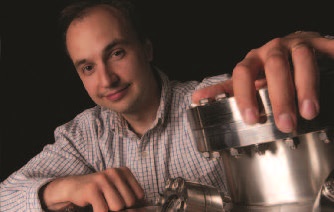
Courtesy of MIT
Trick question. It’s already happened. The two scientific rock stars leading the team that recently created this technology both earned their doctorates at Princeton University. Their résumés are as follows: Dr. Vladimir Bulovi ´ c, (left) Professor of Electrical Engineering and Associate Dean for Innovation at MIT, previously launched a number of technology companies including Kateeva and QD Vision—and is an inventor of over 50 patents in the field of
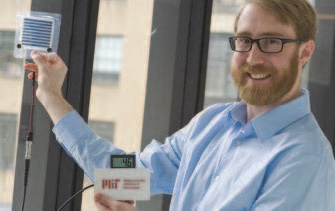
MIT
organic optoelectronics. Dr. Richard Lunt (right) of Michigan State University received his doctorate in chemical engineering from Princeton while working as a researcher there with Dr. Jay B. Benziger, and also with Dr. Stephen Forrest at the University of Michigan. While building his lab at MSU, he worked as a postdoctoral associate at MIT with Dr. Bulovic´. He has won numerous awards for his innovative research and has invented over 15 patents, most of which have been licensed.
In 2011, Bulovic´and Lunt founded their company, Ubiquitous Energy, in Redwood City, CA. This past autumn, they debuted their first practical transparent photovoltaic film prototype, called ClearView Power. ClearView Power transmits up to 90% of visible light, absorbing only ultraviolet and infrared wavelengths. It’s efficient: over 10% conversion to electricity is achievable and independent of its visible spectrum transparency. It’s economical: fabricated using low cost, non-toxic materials, and existing equipment. It’s thin and low-mass: the film is less than 1/1000th of a millimeter thick. And it does indeed have ubiquitous applications, generating electricity on any transparent surface without any aesthetic sacrifice.
This is what the beginning of the end of energy scarcity looks like, ladies and gentlemen. In my humble opinion, in 2028, we might be calling this the greatest technological achievement since the lever or the wheel.

www.istockphoto.com
FASTER! FASTER!
At present, DNA data storage is only experimental. Before it can be introduced to the marketplace, the processes of writing and reading DNA must be improved. Both are prone to error and relatively slow. Today’s DNA synthesis writes a few hundred bytes per second; a modern hard drive writes hundreds of megabytes per second. An average JPEG photo (like the one on the right) takes several hours to store in DNA, while it takes less than a second to save on the phone or transfer to a computer.

www.istockphoto.com
3-D ELEVATOR TRAVEL
With horizontal/vertical elevators coming online this year, the next holy grail for the elevator industry is three-dimensional (X-Y-Z axis) travel—a true Turbo Lift is not beyond the realm of present possibility, but still far from actuality. Currently, the drawbacks include cost. MULTI system elevators are five times as expensive as conventional ones. They won’t be adopted other than as a novelty until the return on investment (of increased throughput and reallocation of space) offsets their installation and maintenance costs. Another possible hurdle is shielding elevator occupants from the strong electromagnetic fields that propel them.
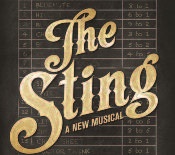
Things to do this Spring
March 29 to April 29
The Sting: A New Musical
Paper Mill Playhouse
(See web site for showtimes)
The con is on with this tale of two hustlers, Henry Gondorff and Johnny Hooker, in a musical inspired by the Oscar-winning 1973 film.
April 12
Ars Vitalis
Kean Stage 7:30 pm
Celebrate the art of music composition in this tribute to the life and work of Frank Ezra Levy, one of New Jersey’s most prolific and gifted composers.

Courtesy of UCPAC
April 14
Arrested Development
UCPAC 8:00 pm
The beloved hip-hop group brings its high-energy act to the Union County Performing Arts Center.

Moscow Ballet/Alexander Daev
April 14
Moscow Festival Ballet: Giselle
State Theatre 2:00 & 8:00 pm
The acclaimed ballet company performs one of the most romantic ballets, with choreography by the legendary Marius Pepita.
 April 15
April 15
Let It Be
NJPAC 3:00 pm
It’s the reunion concert that never was, a time capsule back to John Lennon’s would-be 40th birthday that celebrates the music of the Beatles.
April 15
I Am Tango
UCPAC 6:00 pm
Tango Lovers, the award-winning dance company, tell the story of tango’s evolution through different eras and cultures.

Photo by Kasra Ganjavi for Piedmonstyle
April 19
George Thorogood & The Destroyers
State Theatre 8:00 pm
Boogie blues legend George Thorogood and his longtime band roll into New Brunswick with hits like “Bad to the Bone,” “Move It On Over” and “Who Do You Love.”
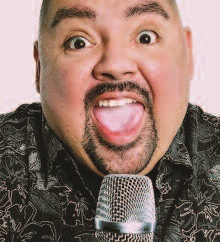 April 21
April 21
Gabriel Iglesias
NJPAC 7:00 & 10:00 pm
The popular comedian comes to NJPAC’s Prudential Hall with two performances on his One Show Fits All tour.
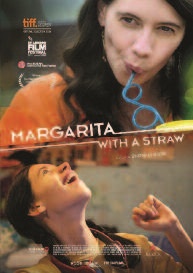
Viacom 18 Motion Pictures
April 22
Margarita with a Straw
Kean Stage 3:00 pm
Margarita with a Straw tells the coming of age story of a Punjabi teen with cerebral palsy.

Photo by Jyle Dupis
April 26
Ruben Studdard
State Theatre 8:00 pm
The Season Two American Idol winner stars in Always & Forever: An Evening of Luther Vandross.

Shen Yun Performing Arts
April 27 to May 3
Shen Yun
NJPAC
(See web site for showtimes)
The world’s premier Chinese dance and music company is in Newark for a week of performances.
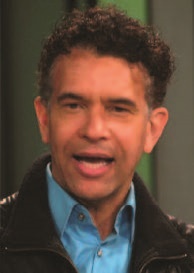
Photo by Phil Konstantin
April 28
Brian Stokes Mitchell
Kean Stage 3:00 & 7:30 pm
Tony-winning song and dance man Brian Stokes Mitchell performs hit songs from his many Broadway shows and his upcoming album Plays with Music.
April 28
Dorthaan Kirk
NJPAC
New Jersey’s First Lady of Jazz is honored on her 80th birthday in the Victoria Theater by music legends Don Braden, Jimmy Heath, Steve Turre and Cassandra Wilson.
May 3
Worship Night In America
Prudential Center
Grammy winner Chris Tomlin headlines a show that includes Kim Walker Smith, Matt Maher, Christine D’Clario, Tauren Wells and Pat Barrett.
FOR THE KIDS
April 14
Journey to Oz
Kean Stage 11:00 am
This new adaptation of Frank Baum’s beloved tales set in the Land of Oz features audience involvement in sound effects and call and response with the onstage characters.
 April 20
April 20
Wild Kratts Live
State Theatre 6:30 pm
Martin and Chris Kratt come to life in a high-energy, multimedia
adventure.
April 29
Charlotte’s Web
UCPAC 2:00 pm
Theatreworks performs the beloved E.B. White tale of a girl and her pig. The production is part of the Sensory Friendly Theatre program, featuring live shows adapted for children with autism and other sensory sensitivities.
May 4 & 5
The Wizard of Oz
State Theatre 2:00 & 7:00 pm
A spectacular celebration of the iconic 1939 MGM film, starring Dorothy and Toto, along with the Scarecrow, Tin Man and Cowardly Lion. There is no 2:00 pm performance on the 4th.
 May 12
May 12
Panda-Monium
NJPAC 2:00 & 3:30 pm
The New Jersey Symphony Orchestra performs Music from the Animal Kingdom in a pair of family-friendly afternoon programs.
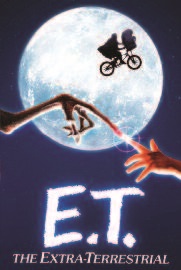
Universal Pictures
June 3
E.T. The Extra-Terrestrial
State Theatre 3:00 pm
Constantine Kitspooulos conducts the New Jersey State Orchestra in John Williams’s Oscar-winning score live during a screening of E.T.

Courtesy of NJPAC
May 4
The Piano Guys
NJPAC 8:00 pm
The YouTube sensations blend a wide range of iconic music, from Bach to Bruno Mars.
May 5
New Jersey Symphony Orchestra
NJPAC 8:00 pm
Violinist Ning Feng is the main soloist and Dima Slobodeniouk conducts the NJSO in a program featuring Mendelssohn’s Violin Concerto.
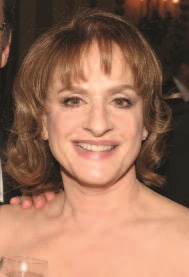
The Drama League
May 6
Patti Lupone
State Theatre 4:00 pm
Tony winner Patti Lupone takes the stage in Don’t Monkey with Broadway, her tribute to the unforgettable show tunes of the Great White Way.

Knight Foundation
May 11 to 13
Alvin Ailey American
Dance Theater
NJPAC
(See web site for showtimes)
The company’s annual stop in Newark features Revelations, the signature masterpiece that pays homage to the African-American experience.

Courtesy of NJPAC
May 12
Marin Mazzie & Jason Danieley
NJPAC 6:00 & 8:30 pm
The golden couple of Broadway performs beloved show tunes in the intimate setting of NJPAC’s Chase Room.
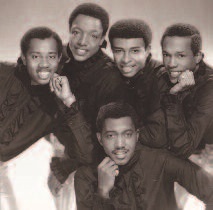
Motown
May 13
The Temptations & The Four Tops
State Theater 7:00 pm
Two of the greatest Motown acts join forces in New Brunswick for a live concert featuring all of their signature hits, from “My Girl” to “I Can’t Help Myself.”
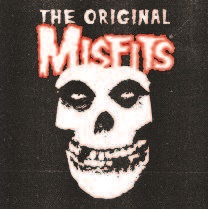 May 18 & 19
May 18 & 19
The Original Misfits
Prudential Center
Glenn Danzig and Jerry Only reunite in their return to New Jersey, where it all started three decades ago for the legendary horror-punk-metal pioneers.
May 19
William Shatner
NJPAC 7:30 pm
William Shatner (aka James T. Kirk) takes the Prudential Hall stage following a screening of Star Trek II: The Wrath of Kahn.
May 20
New Jersey Symphony Orchestra
State Theatre 3:00 pm
Violinist Eric Wyrick is among the featured NJSO soloists in a performance of Bach’s complete Brandenbrg Concertos.
May 31 to July 1
Half Time
Paper Mill Playhouse
(See web site for showtimes)
From the director-choreographer of Kinky Boots comes the remarkable true story about a group of seniors who became hip-hop dancers for a big-time basketball team.
June 15
Happy Together
State Theatre 8:00 pm
An all-star constellation—including The Turtles, The Cowsills, and Gary Puckett & The Union Gap—performs beloved hits from the 1960s and 1970s.

Travis Shinn
June 15
Journey + Def Leppard
Prudential Center 7:00 pm
Don’t stop believing—both bands have created all-new shows for their 2018 tour, which stops in Newark on the 15th.
Editor’s Note: This overview of local entertainment, curated by Rachel Stewart, is just a taste of our area’s overall performance picture. For full listings, log onto the following web sites:
Kean Stage • keanstage.com
Paper Mill Playhouse • papermill.org
State Theatre • stnj.org
NJPAC • njpac.org
Prudential Center • prucenter.com
Union Country Performing Arts Center & Hamilton Stage • ucpac.org
Cryotherapy is coming to a health club near you. Is that a good thing?
By Mike Cohen
In the classic sci-fi film Logan’s Run, set in the year 2274, citizens of a certain age entered a special chamber called the Carousel, where they were “renewed.” It turned out that was future-speak for being vaporized. Renewal has a different look in 2018, although in the case of cryotherapy, it still has a futuristic feel. Across the country, citizens of a certain age are discovering the renewing benefits of the cryosuana chambers that have started to pop up in gyms, health clubs and spas. You may have seen one; it’s an insulated standalone chamber that you stand in, with protection for your hands, feet and private parts, and your head exposed at the top.
 Cryotherapy is an ergonomic modality used to address a wide range of aches, pains and medical conditions. It also has benefits for athletes looking to improve their performance. The ancient Greeks and Romans used cryotherapy (immersion in chilly seawater) to treat inflamed wounds. In the 19th century, European medicine rediscovered this technique. A couple of generations ago, cryotherapy looked a lot different: a bag of ice wrapped around a knee or shoulder, a chilled whirlpool bath. In the 1970s, Japanese researcher Dr. Toshiba Yamauchi pioneered the concept of whole-body cryotherapy to treat rheumatoid arthritis and, in doing so, began to notice its therapeutic side effects for subjects who suffered from injuries and chronic inflammation. Since then, there has been a huge amount of medical information coming out about this technology and how it can benefit the human body in myriad ways.
Cryotherapy is an ergonomic modality used to address a wide range of aches, pains and medical conditions. It also has benefits for athletes looking to improve their performance. The ancient Greeks and Romans used cryotherapy (immersion in chilly seawater) to treat inflamed wounds. In the 19th century, European medicine rediscovered this technique. A couple of generations ago, cryotherapy looked a lot different: a bag of ice wrapped around a knee or shoulder, a chilled whirlpool bath. In the 1970s, Japanese researcher Dr. Toshiba Yamauchi pioneered the concept of whole-body cryotherapy to treat rheumatoid arthritis and, in doing so, began to notice its therapeutic side effects for subjects who suffered from injuries and chronic inflammation. Since then, there has been a huge amount of medical information coming out about this technology and how it can benefit the human body in myriad ways.
Back to the cryosauna chamber. Liquid nitrogen gas is expelled at –200⁰C and blown around your body in the chamber, escaping from the top. It’s all over in three minutes. You’re shivering, yes, but you quickly warm up and experience a particular euphoric feeling, which keeps a lot of folks coming back. “Regulars” often schedule sessions every one to two weeks.
What exactly is going on with this cold air and your inflammation/injury? The cold blast hits the skin and the blood vessels constrict. The skin doesn’t “like” the cold and shunts blood to the center of the body, the core, to keep it warm. The autonomic nervous system—which controls automatic stuff like breathing and heart rate— begins to take over. It is composed of the sympathetic (fight or flight responses) and the parasympathetic, which conserves energy and relaxes things. The body begins to shiver, contracting muscles to stay warm, and increases the metabolic rate. This is the sympathetic part. The chemical mediators that started this process are basically put into hibernation and the tissues’ response is one of slow motion. The blood slows down in the extremities and, in turn, slows down what is called oxidative stress to the tissues (aka free radical formation).
Another part of the autonomic nervous system, the parasympathetic system, when exposed to cryotherapy, begins its magic with releasing noradrenaline from the nervous system. This helps to alleviate pain along with several other actions. Increased parasympathetic activity has been linked to exercise recovery and a reduction in cardiovascular risk for stroke or heart attack
Medicine can be so boring, right? So let’s skip to the good stuff. Why would cryotherapy be something of interest to you? Well, there are many medical issues where this type of treatment has been tested and the results are pretty eye-opening. For example, studies have shown remarkable improvement in low back pain with as little as 10 sessions of three minutes duration each.
Another area where cryotherapy has proved to be effective is sleep. A study of elite basketball players from Europe showed a 15% improvement in the quality of their sleep with as little as one session. The maximal effect was demonstrated after 10 sessions.
Currently, the main customers for cryotherapy are seeking relief and recovery from the pains and strains of physical exercise. When we exercise strenuously, we release inflammatory compounds like CRP (C Reactive Protein), and inflammatory cytokines—including Tumor Factor, Interleukin and Interleukin 6—into the circulatory system. Not good. Pain, swelling, stiffness, loss of motion all come with “overdoing it.” Free radicals are also part of the picture, generated during exercise. These free radicals attack cell walls, especially the lipid (fatty) parts, which causes cells and blood vessels to leak. With cryotherapy there is a dramatic reduction in these factors by virtue of cryo’s ability to generate an Interleukin inhibitory factor, and by releasing an anti-inflammatory cytokine called Interluekin 10.
I know. It can be a little confusing. But here is the takeaway: Even after a single three-minute exposure, there is medical proof that the inflammatory chemicals begin to reduce in concentration in the blood. Strength can actually increase after cryo treatment. Power also can improve after as little as one to three sessions. And, for all those runners/rowers out there, the body’s VO2 Max is increased after as little as three exposures. Athletes having been “cooling it” before competing and noting an increase in performance. The NBA Dallas Mavericks and the NFL Dallas Cowboys are among the pro teams that have these machines.
There is also evidence that cryotherapy can benefit individuals experiencing depression and anxiety, as pain can be the underlying issue in both cases. By exposing the body to cryotherapy, it increases the metabolic rate —as detailed above—which brings with it an increase of catecholamines, such asepinephrine, norepinephrine and dopamine. Also cortisol, ACTH and endorphins are increased as a result. These are all ingredients for improving one’s mood and attitude. In the brain there is a system called the Opioid Peptide System, which regulates motivation, emotion, responses to stress, and control of food intake. You can see how this is part of the depression and anxiety issue. With cryotherapy, this Opioid Peptide System is stimulated to release these chemicals into the brain. Indeed, medical studies have shown significant improvement after only five sessions.
One final aspect of cryotherapy that is worth noting is that its benefits are cumulative. The more you do it, the better things tend to get. That sounds like a good business model, doesn’t it? It’s another reason you may be seeing cryosuana units coming to a location near you.
What Exactly Is Inflammation?
We have all seen inflamed joints, tendons, and extremities. Hot, sometimes swollen and painful limbs, spine and joints all tell us that we have either done too much in the gym or have been subjected to injury. Inflammation and injury start with the vascular system. Small arteries and veins are part of the capillary system, where they are renamed arterioles and venules. These are called the endothelium. With trauma or overuse, the endothelium becomes sticky and attracts platelets and leukocytes (white blood cells) that clump together at the site of injury and begin to decompose. Doctors call this degranulation. Once this happens, there are all sorts of chemical compounds released by these cells to create a pulling-back of the endothelium, creating gaps inside the walls of vessels. These compounds have nasty names like tumor necrosis factor and interleukin 1. Additionally, free radicals, histamine and serotonin are generated and all swim in the same pool of liquid inside the vessel. With the gaps created, the liquid inside the vessel, lets call it plasma, leaks out into the surrounding tissues, joints and muscles and creates swelling and irritation. This liquid has a higher protein content than inside the vessel, and therefore more liquid from inside the vessel tries to dilute the protein outside the vessel. Then the body attempts to heal itself with more cells “coming to the rescue”—namely macrophages, which are human waste disposals. They grind up and eat the damaged tissue so that new tissue can be laid down. However, this process is not fun. It hurts. It’s the body’s way of saying, “I need some time off to heal this problem.”
CRYOTHERAPY AND DISEASE
Rhuematoid Arthritis
This is a disease where the body is essentially destroying itself, eating away at soft tissue and bones. Studies have shown that some of the chemical factors involved in this disease are Interleukin and Tumor Necrosis Factor. With cryotherapy—and from here on I am talking about the cryosauna unit—exposure does remarkable things to the blood work of rheumatoids. With 10 exposures of three minutes. there is a significant drop in these chemical markers, which in turn decreases pain, inflammation, and degradation.
Fibromyalgia
A difficult diagnosis to deal with, as this is a diagnosis often arrived at after loads of negative testing results. The anguish of chronic pain, often from a neurological basis, is distracting to patients. Cryotherapy has shown that, with as little as 15 treatments of 30 seconds in duration, there is a dramatic effect on reducing pain.
Multiple Sclerosis
MS is a debilitating disease of the muscles and nerves.
Fatigue was the overwhelming issue in most MS patients when questioned about their disease. With 10 three-minute exposures, there is a significant reduction in fatigue of the skeletal muscles.
EDITOR’S NOTE: Although thousands of athletes, including LeBron James, swear by whole body cryotherapy, the FDA has not approved any WBC devices. It’s a good idea to discuss cryotherapy with your doctor, especially if you plan to replace more traditional treatment options for medical conditions.
While other charitable groups are devoted to raising money, HFNJ focuses on how best to spend it.
By Yolanda Navarra Fleming
The Healthcare Foundation of New Jersey (HFNJ) has been a nurturing force in the greater Newark, NJ area and the Jewish community of MetroWest since 1996, when it was formed from the sale of Newark Beth Israel Medical Center to the Saint Barnabas Corporation. As a champion donor to Trinitas, the HFNJ’s extreme generosity to the hospital dates back to 2000, totaling 21 grants to the rather significant tune of $3,374,132.
According to Marsha I. Atkind, Executive Director/CEO, the HFNJ functions a bit differently than one might expect. Rather than working to raise funds, the board plays an active role in making decisions about applicants’ proposals and projects.
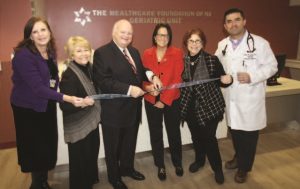
Kathleen Shevlin, Director of Resource Development;
Nadine Brechner, Vice President of the Trinitas
Foundation; Gary Horan, Trinitas President/CEO; Dr. Beth
Levithan, HFNJ Chair; Marsha Atkind, Executive
Director/CEO of HFNJ; and Dr. John D’Angelo of Trinitas
take part in the ribbon cutting of The Healthcare
Foundation of NJ Geriatric Unit.
“We have a strong endowment,” says Atkind, a University of Pennsylvania graduate, who studied at Columbia University Law School. “(The late) Lester Lieberman, our founding chairman, was the chair at Newark Beth Israel when the sale took place. He made that sale happen and his vision made the HFNJ happen. We owe everything to him.”
At one time a stay-home mother, Atkind got involved in women’s issues and became President of the National Council of Jewish Women in 2002. When her term was up, she was hired by the Jewish Federation of MetroWest to start a women’s foundation. In 2008, she was recruited to the HFNJ.
“In our 21-year history, we’ve given away about $135 million dollars, the lion share in greater Newark,” remarks Atkind. “We fund everything from major pieces of equipment, as we’ve done for Trinitas in the Emergency Department, to programs at grassroots agencies that help people improve their health and wellness.”
As needs arise, Nadine Brechner, Vice President/Chief Development Officer at Trinitas, remains grateful that the HFNJ’s generosity doesn’t begin and end with money. Trustees and staff spend their time working closely with applicants to get to know the challenges of their goals and how to best meet them, which sometimes means reshaping and improving proposals.
“Marsha, her staff and trustees are all fantastic,” says Brechner, who works closely with them on projects from start to finish. “They have taken an active interest in our patients and visit frequently. Whenever I’ve gone to them with our needs—both big and small—they’ve always found a way to help. They also question our proposals. And they follow up because they want to know that they have truly helped. They are true partners.”
An example is the new Gary S. Horan Emergency Department at Trinitas, a 24,000-square-foot renovation that nearly doubled the amount of beds and created separate treatment areas for the consideration of seniors, families and behavioral health patients.
“Their gifts have literally touched almost every aspect of care at Trinitas, which is why the HFNJ will be honored at the 2018 Peace of Mind Gala this year,” says Brechner.
 By definition, the HFNJ’s mission is to improve the health and well-being of vulnerable, underserved populations in greater Newark and the Jewish Community of MetroWest NJ, to elevate the quality of community healthcare, reduce disparities in access, and promote the infusion of compassion and humanism into our healthcare system. Dr. Beth Levithan, chair of the HFNJ, who joined the board in 1997, is most proud of the HFNJ’s commitment to humanism.
By definition, the HFNJ’s mission is to improve the health and well-being of vulnerable, underserved populations in greater Newark and the Jewish Community of MetroWest NJ, to elevate the quality of community healthcare, reduce disparities in access, and promote the infusion of compassion and humanism into our healthcare system. Dr. Beth Levithan, chair of the HFNJ, who joined the board in 1997, is most proud of the HFNJ’s commitment to humanism.

Geriatric Unit
“There is a focus on humanism in every grant we fund and everything we do,” says Levithan, the former adjunct professor at the Rutgers School of Social Work in New Brunswick, and senior researcher/evaluator at the Research Center at John Jay College of Criminal Justice in New York.
“Les was passionate about inspiring our Board with that mission. He always emphasized treating people, not their diseases, as the key to successful healing and wellness. The Healthcare Foundation of NJ Center for Humanism and Medicine, which was founded and funded by HFNJ at Rutgers New Jersey Medical School in 2004, is only one example of this emphasis.”
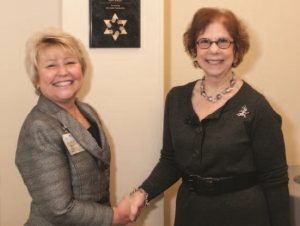
Nadine Brechner, Vice President/Trinitas Health
Foundation and Marsha Atkind, Executive Director/CEO
of HFNJ shake hands during the CORE Building
dedication.
Arnold and Sandra Gold of the Arnold P. Gold Foundation were a pivotal influence on Lieberman and the HFNJ. “The most wonderful evening of the year for HFNJ is when we give out the Lester Z. Lieberman Humanism in Healthcare Awards to individuals nominated by our grantees as excellent examples of humanistic caregivers,” she adds. “Les and Arnold Gold are now deceased, but they would be so pleased to know their work will continue at HFNJ reaching the most vulnerable populations they both wanted to serve.”
The HFNJ was one of the early champions of HIV-AIDS programs and has prioritized projects aimed at early development, disabilities, and parenting. One of HFNJ’s biggest successes is Mom2Mom, a telephone peer support program run by Rutgers University Behavioral Health designed to have mothers of children with disabilities answer questions posed by other mothers with similar issues. Mom2Mom began locally and has now grown to serve mothers throughout the US.
“Some of the work we’ve done has been to help mothers bond with their infants and be the best parents they can be,” says Atkind. “We feel so strongly that if children start off on the right foot, a lot of the problems later in life could be alleviated or possibly eliminated. We know how hard it is to raise children, especially in today’s world with all the responsibilities and issues brought on by poverty, racial and cultural disparities, and technology. Programs that support mothers and teachers are crucial to the health of our country moving forward.”
Women, in general, can be grateful for the HFNJ’s most recent pledge for the new Connie Dwyer Breast Center to pay for the Hologic Selenia 3D Mammography System, the latest technology for detecting invasive cancers.
“HFNJ initially helped us update our technology when we went from film to digital imaging,” says Brechner. “They care about our moms and have been caring for them fora long time.”
THE HEALTHCARE FOUNDATION OF NEW JERSEY HAS SUPPORTED TRINITAS WITH THE FOLLOWING GRANTS:
Connie Dwyer Breast Center
Most recently, a $348,467 grant will cover the balance needed for a Hologic Selenia 3D Mammography System for the New Connie Dwyer Breast Center. This system will be the centerpiece of the new Center. Now the industry standard, 3D mammography technology, can detect 41% more invasive cancers than older methods while reducing false positives by 40%. With this grant, Trinitas will be able to provide the highest quality, potentially lifesaving diagnostic care to the underserved women of the region.
Emergency Department
These are among the latest and largest gifts they have given to Trinitas. In all, HFNJ gave $1.75 million to the Proud Past, Promising Future Campaign with the following components:
- The Healthcare Foundation of New Jersey Transitional Care Unit: $1,000,000 (10/2016). Through this grant, HFNJ funded the construction costs for the Transitional Care Unit. This unit was created as a designated space to safely stabilize, diagnose and provide medical clearance to patients who are experiencing a psychiatric and/or substance abuse emergency. The HFNJ Transitional Care Unit served 6,544 patients in 2017— more than triple our initial projection of 2,000 patients per year.
- The Healthcare Foundation of New Jersey Geriatric Unit: $500,000 (December 2015). The purpose of this project was to create a model for urban safety-net hospitals that ensures that seniors receive the safest, most comfortable and clinically sound care in an environment that respects their privacy and dignity. This five-bed unit was on track to serve 5,700 patients in its first full year of operation.
- Emergency Department Diagnostic Unit CT Scan: $250,000 (August 2014). HFNJ gave a $250,000 grant for the 128 slice CT Scan, which is the centerpiece of the ED Diagnostic Unit. Hospital-Acquired Delirium HFNJ took a leadership role through its initiative aimed at tackling Hospital Acquired Delirium (HAD) across New Jersey. Two grants totaling $242,048 provided salary support and supplies to establish a hospital-acquired delirium program, devoted primarily to aiding seniors on our inpatient units. The foundation also provided an additional grant to ensure that the program would be fully established over the long-term.
Ambulatory Surgery Center
A $149,134 grant in 2014 helped purchase two pieces of equipment for the Ambulatory Surgery Center. HFNJ also gave grants for the Behavioral Health EMR Project ($148,500), Surgical Equipment ($150,000), the first Digital Mammography Suite ($100,000) and other projects.
News, views, and insights on maintaining a healthy edge.
Back to the Future
Drug-resistant bacteria is responsible
for more than 20,000 deaths a year in the United States, and the CDC warns that this number is unlikely to go down until a new antibiotic comes on the scene. Is Octapepin the answer? If so, it’s a case of “back to the future,” as this drug was developed in the 1970s…and then dropped.
According to the journal Cell Chemical Biology, researchers at the University of Queensland in Australia noticed that Octapepin is similar in structure to Colistin, which is currently used as the last resort drug against antibiotic-resistant bacteria. The toughest bacteria to fight have an extra membrane to penetrate, which is camouflaged from drugs, as well as the human immune system. Because Colistin is effective against this additional layer, the hope is that Octapepin will be, too.
If so, it should replace Colistin, which can wreak havoc with the kidneys and other internal organs. Octapepin was shelved in the 1970s and’80s because so many other powerful antibiotics were hitting the market during this time.
New Blood Test Detects 8 Forms of Cancer
Scientists at Johns Hopkins recently announced a universal blood test that detects eight of the most common types of cancer. The test looks for trace amounts of mutated DNA and proteins that are released into the bloodstream by tumors. By identifying each type of cancer before it has time to spread, the test promises to have a major impact on the mortality rate from the disease. The most recent trial showed a 70 percent success rate in detecting cancer among study subjects. Ovarian cancer was the easiest to detect, followed by liver, stomach, esophageal, colorectal, lung and breast cancer. Although current blood tests can detect cancer, none have been able to pinpoint the type of cancer with significant accuracy.
Researchers were quick to point out that most of the cancers detected were advanced stage two or stage three, but there is hope that the test can be refined to catch the disease in its pre-symptomatic stages.
Breakthrough for Central Sleep Apnea Sufferers
Sleep apnea, a breathing disorder that affects an estimated 1 in 15 Americans, has been getting a lot of attention lately. Even if you are one of the 14 that doesn’t suffer from this disorder, you may have noticed an increase in ads for CPAP devices, as well as louder debates about whether sleep-deprived sleep apnea sufferers should be allowed to operate trains, planes and automobiles. Sleep apnea comes in two varieties, obstructive and central. Obstructive sleep apnea, which is caused by an upper-airway blockage, is the most common and controllable. Central sleep apnea is far more dangerous. It happens when the brain and diaphragm don’t communicate, resulting in lapses in breathing. Some lapses can last a minute or more. Late last year, the FDA approved an implanted device for central sleep apnea patients that should be available sometime in 2018. Marketed under the name Remede, the neuromodulation system activates a nerve that sends signals to the diaphragm to stimulate breathing. It is one of several new products on the horizon for sleep apnea sufferers—an estimated 40 percent of whom refuse to wear a CPAP device.
“Perfect Storm” Flu Season
So what did we learn from the recent, and particularly bad, flu season? Stay at home. The relative ineffectiveness of this year’s vaccine (estimates range from 10 to 22 percent effectiveness)—combined with regional shortages of Tamiflu and a robust employment picture—created a perfect storm for transmission. Although most flu sufferers followed the basic medical advice to stay in bed, drink fluids and take fever reducers, many went back to work (or school) too soon. Most doctors recommend staying home an additional 24 hours after you “feel fine.” Although healthy adults and children will recover from the influenza virus, it can be deadly for those with weakened immune systems, as the virus can lead to pneumonia. The World Health Organization links between 290,000 and 650,000 fatalities each year to flu epidemics. Four in five flu deaths worldwide occur among people 65 and older.
New Benchmark for Gene Therapy
For the 1,000-plus individuals in the U.S. with a rare, inherited retinal disorder caused by a defective gene called RPE65, 2018 holds incredible promise. The rest of the medical profession is also excited, because the FDA’s approval of Luxturna marks the first time it has OK’d a “true” gene therapy treatment to reach the market. Gene therapy involves the delivery of a healthy copy of a gene to make up for one that is unhealthy. The RPE65 gene is responsible for a protein that makes light receptors in the eye. Patients that inherit a defective version of the gene suffer from retinitis pigmentosa and eventually go blind. Luxturna is injected into each eye with a single dose that uses a benign virus to deliver healthy copies of the RPE65 to the retina. Though not a cure, it has been shown to improve eyesight substantially. The bigger picture surrounding FDA approval of gene therapy is intriguing, to say the least. Because many cancers begin with a DNA defect, gene therapy (which has been under development for two-plus decades) could become a major weapon in the fight against the disease.
Warming Up to Saunas
There are now more than a million saunas in the United States, including home units and those in health clubs, spas and resorts. Those who swear by saunas got some good news recently when a study out of Finland pinpointed a specific benefit for middle-aged adults at risk for heart disease. Researchers found that a 30-minute session at 160 degrees decreased blood pressure by seven points and increased arterial elasticity. Heat exposure can widen blood vessels and promote better blood flow, easing the workload for the heart. Study subjects had at least one of the three conditions: obesity, high blood pressure or high cholesterol. Saunas gained an initial foothold among Americans in the 1950s, after the Helsinki Olympics. Finnish athletes attributed their medal-winning performances to the incorporation of saunas into their training routines.
Booze News Not Good for Heavy Drinkers
A new study from the University of Toronto has drawn some alarming conclusions about the long-term effects of heavy drinking. Researchers looked at the medical histories of a million individuals diagnosed with dementia over a five-year period and found that the strongest predictor for this condition was a previous hospitalization for issues related to alcohol consumption. More than half of early-onset dementia cases were linked to alcohol-related brain damage. Of the 5.5 million cases of Alzheimer’s dementia in the U.S., about 200,000 are considered early-onset. One in 10 Americans over the age of 65 has some form of dementia. Heavy drinking is defined as four or more drinks per day for men and three a day for women.
The Hidden Cost of Climate Change
Does climate change impact health? The devastating aftermath of the 2017 hurricanes in the Gulf of Mexico and the Caribbean has focused much attention on this relationship. While the response to each disaster teaches us something new about how to deliver healthcare to stricken areas, each disaster also demonstrates how natural disasters can undermine healthcare in vulnerable parts of the world. In many places, the disasters are actually the source of public health crises. This, maintains the World Health Organization, which is the “hidden” cost of climate change. The situation is exacerbated by bureaucratic tinkering with post-disaster statistics. For instance, only 64 deaths in Puerto Rico were officially attributed to Hurricane Maria. The apocalyptic images that we saw suggest a different story. And indeed, the deaths related to a “disruption in healthcare” on the island surged well past 1,000 in the weeks that followed.
 Poets have been writing odes to mothers for a thousand years. Baby books have been offering advice to moms for a century. Alas, no words convey the true essence of motherhood quite like the intimate moments captured through the lens of celebrated lifestyle photographer Sue Barr. Her work offers an honest and engaging window into what it looks like to be a modern New Jersey mom.
Poets have been writing odes to mothers for a thousand years. Baby books have been offering advice to moms for a century. Alas, no words convey the true essence of motherhood quite like the intimate moments captured through the lens of celebrated lifestyle photographer Sue Barr. Her work offers an honest and engaging window into what it looks like to be a modern New Jersey mom.





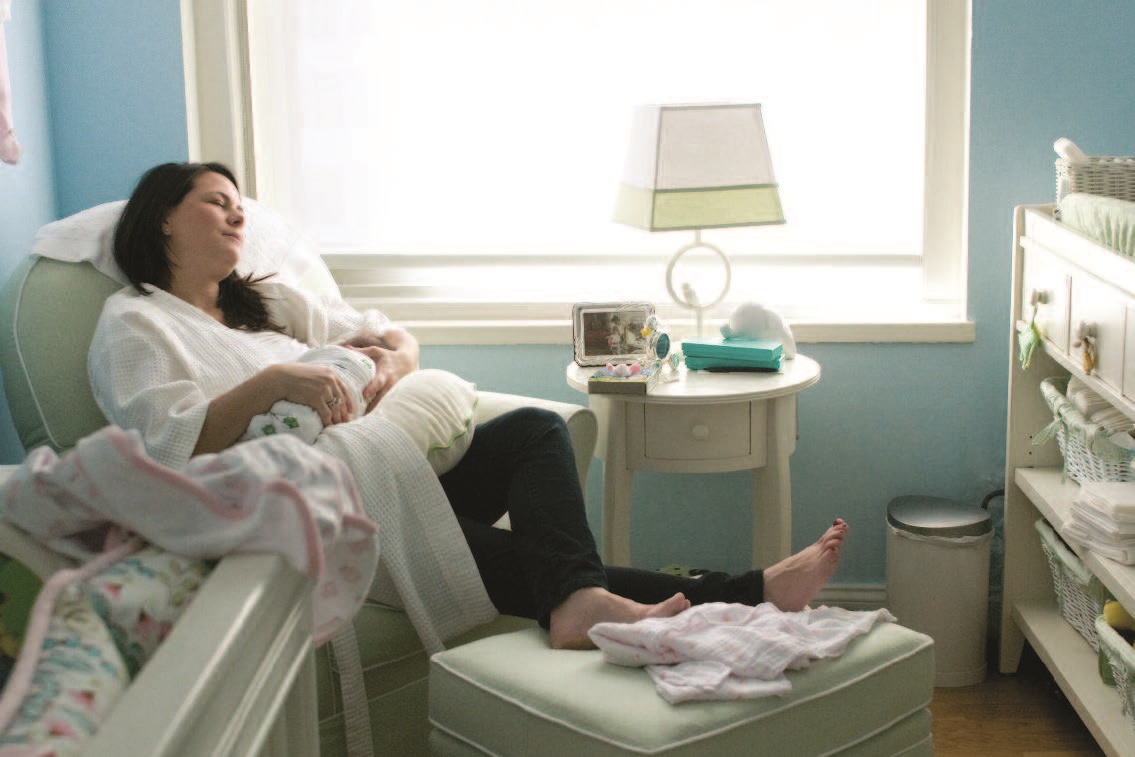




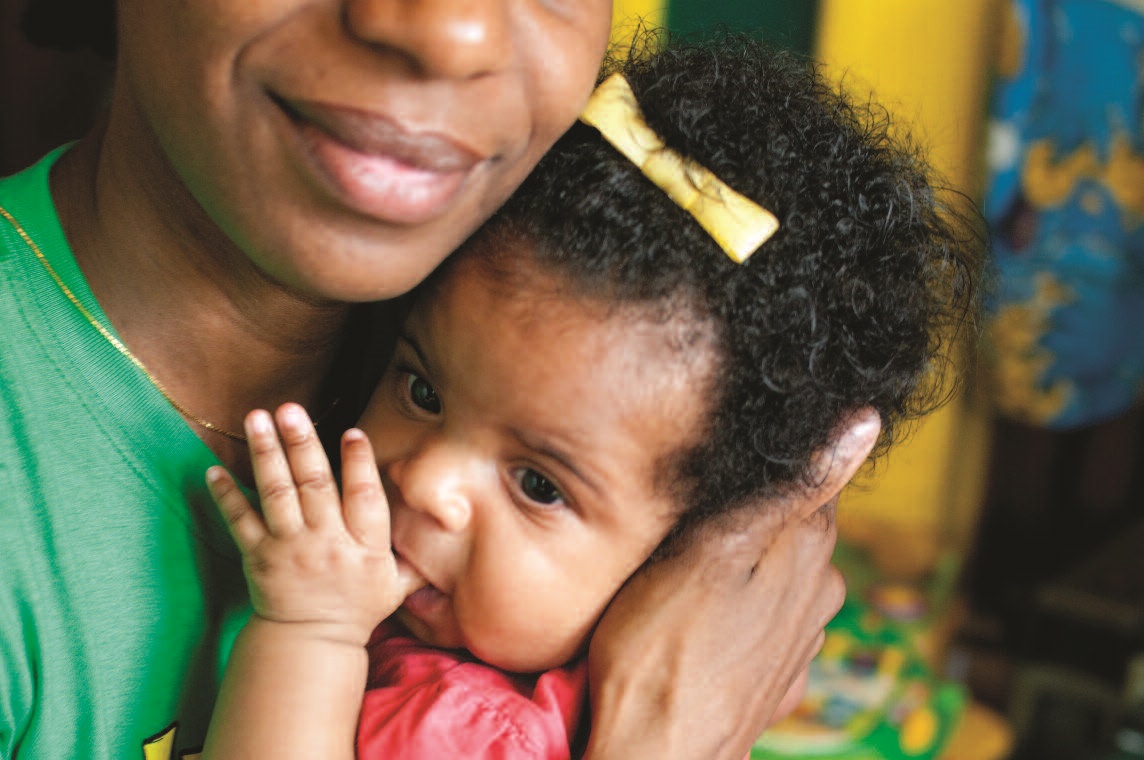

Sue Barr is a winner of annual American Photographic Artists awards for Advertising, Sports & Adventure, Portrait and Lifestyle. Her fashion photography has been featured in EDGE during its first year of publication. You can see more of her work at suebarr.com.
So you think your mother-in-law is bad…
By Sarah Rossbach
My husband used to tease me that my mother paid him a huge fee to marry me. But that jest perhaps hides the real truth: On Christmas Eve, the year we were married, my mother-in-law, martini glass in hand, cornered me at a family gathering and tearfully thanked me for marrying her middle son. While no money was exchanged, I registered the gratitude that with her son in my hands, she had one less worry on her mind. I must admit I was lucky in the mother-in-law department.
Mother-in-law. An appellation so resonant that it is almost onomatopoetic in evoking a mixture of fear, humor invasiveness and sometimes loathing. My father used to say that he married a “Rose that grew from a dung heap.” And when my mother married my dad, her new sister-in-law took her to lunch to warn her about the well-manicured claws of her future mother-in-law. My mother actually got along swell with my grandmother, perhaps because she was a vast improvement to her own mother. Meanwhile, the sister-in law’s mother was referred to by her husband as “The Toad.” That being said, mothers-in-law can occasionally be outright fun. An older friend said his early-to-bed wife’s night owl mother used to commandeer him after the witching hour to squire her around to Palm Beach nightclubs. (And here’s to you, Mrs. Robinson!)
The evil or comic mother-in-law has been a casting staple in Hollywood: From the movie Monster-in-Law to Samantha’s mother, humorously invasive and sardonically witchy Endora, on Bewitched to Game of Thrones’ murderous Olenna Tyrell, the theme of mothers-in-law is rich territory.
Mother-in-law stories start with the tying of the knot. There are endless stories of mothers of the groom wearing funereal black at the wedding, or trying to upstage the bride by wearing white. And then there are the mothers-in-law, with shriveled hearts, who forgo the wedding altogether. Probably good riddance. No one could be good enough for Sonny Boy or perfect Poopsie. The umbilical cord knows no ends. Oedipus, anyone? Speaking of Oedipus: imagine the nightmare of his mother, Jocasta, who by unwittingly marrying her son, incestuously became her own mother-in-law.
Mothers-in-law may have the best intentions, such as Recounted that, on a first visit to her husband-to-be’s hometown, his mother drove her around on a tour of all her son’s ex-girlfriends’ houses. The not-very veiled message being: there were many before and, if she didn’t take good care of him, there could be many afterwards.

www.istockphoto.com
My own area of study is Chinese culture, where there are hundreds of stories of young Chinese wives becoming slaves to their tyrannical mothers-in-law, thanks to Confucian expectations of filial piety, respect and obeisance: The custom was that, on marriage, the wife moved into her husband’s multi-generational home and was at her mother-in-law’s beck and call. The mother-in-law continued a cruel cycle of abuse, no doubt similar to how her own mother-in-law treated her. There are so many examples in Chinese history and fiction of wretched mothers-in-law that one doesn’t stand out as more horrible than the others.

Library of Congress
Which is better—the coldly snubbing or the insanely smothering mother-in-law? History has something to say about that. In the 19th Century, when John Ruskin, the Scottish art critic and champion of Pre-Raphaelite artists, married at his mother’s urging the high-spirited Effie Gray, he caught a chill on their honeymoon and had to be nursed back to health by his mother. However, his mother’s lack of boundaries in over-nurturing Ruskin can’t be the only cause of six years of an unconsummated marriage. With reason, Effie annulled their union and married Ruskin’s more handsome and appreciative protégé, the painter John Everett Millais.
The White House has housed four mothers-in-law and, not just one, but two of them were domineering and judgmental. When Franklin Delano Roosevelt proposed to Eleanor, his meddling mother Sara took him abroad to discourage their union. When that didn’t work, she built double townhouses in New York as a wedding present, so she could be near her dear one. Wherever they lived, she always shared a roof. Her overbearingness did “save” the marriage, as she objected to the possibility of Franklin divorcing Eleanor when he strayed from the marriage, saying she would cut him off without a dime. FDR’s successor, Harry Truman, gained a disapproving mother in- law when he married Bess Wallace. Bess’s mother never considered Harry—a former dirt farmer and failed shopkeeper—good enough for her daughter, even when he became president (!) and she settled into 1600 Pennsylvania Avenue.

Victoria and Albert Museum
History offers plenty of Game of Thrones-esque stories about overbearing and conniving (to the point of felonious and even homicidal) mothers-in-law. In the 16th century, Mary Stuart, aka Mary Queen of Scots, after her husband Francis II’s untimely death, was cast out by her mother-in-law, Catherine de’ Medici (right). Mary fled to Scotland, leaving the Crown Jewels behind at Catherine’s insistence. (But that was certainly better than the imprisonment and beheading that ultimately awaited her in Scotland.) Catherine also tangled in her daughter’s marriage and may have poisoned her son-in-law’s mother as well as caused religious riots. And although one marries for better or worse, it couldn’t get worse than the domineering Bona Sforza (1494- 1557), the poisonous and poisoning Italian-born Queen of Poland. Bona, by all accounts, was a horrible mother to her five children, but she was far worse to her daughters-in-law. After unsuccessfully attempting to prevent her son’s marriage to Elisabeth of Austria, she is said to have poisoned Elisabeth within two years. Her son remarried his mistress, who quickly and mysteriously died mere months after the wedding.

www.istockphoto.com
We may feel safely centuries away from these murderous mothers-in-law, but the beat goes on. Closer to here and now, in 2013, a Florida newspaper reported that a 70-year-old grandmother allegedly offered a supposed hitman $5,000 to knock off her daughter-in-law. Fortunately for the intended victim, the hitman was an undercover cop.
FUNNY YOU SHOULD MENTION

Dell Publishing
Darrin Stephens’s mother-in-law, Endora (played to virtuoso perfection by Mercury Theater veteran Agnes Moorehead), earns high marks as one of TV land’s great sitcom mothers-in-law. Moorehead is hardly alone. Some of history’s finest character actors have made this role their own on the small screen.
- In the 1960s, Eve Arden and Kaye Ballard took turns chewing the scenery in the sitcom The Mothers In Law. They played embattled neighbors whose children married, forcing their parents into uncomfortable closeness week after week.
- On The Honeymooners, the mere mention of Alice Kramden’s mother (played by sneering Ethel Owen) sent Ralph into a quivering rage. She rarely missed an opportunity to mention the boys her daughter could have married…and once had Ralph arrested as a counterfeiter.
- Sitcom mothers-in-law could be tough on daughters, too. Frances Sternhagen, who gained TV fame as Cliff Clavin’s mother on Cheers, was even better as Bunny MacDougal on Sex and the City. Bunny took meddling in the lives of Trey (her son) and Charlotte to a whole new level.
- On Everybody Loves Raymond, Doris Roberts made Debra’s life a comic nightmare, while standing up for her son at almost every turn. Roberts was nominated for seven Emmys as Marie Barone.
EDITOR’S NOTE: Ambitious mothers-in-laws always run the risk of a double-edged sword. Literally. When King Herod the Great discovered his mother-in-law and her daughter were conspiring to regain power for their dethroned family, he had both executed.
EDGE takes you inside the area’s most creative kitchens.
 Paragon Tap & Table • Beef Ramen
Paragon Tap & Table • Beef Ramen
77 Central Ave. • CLARK
(732) 931-1776 • paragonnj.com
As we constantly introduce new flavors from around the world to our customers at Paragon Tap and Table we have added an Asian inspired Noodle Dish with a touch of the south. Our beef ramen noodle showcases all the characteristics of a traditional ramen but twisted with the smokiness of the smoked beef brisket.
— Eric B. LeVine, Chef/Partner
 Arirang Hibachi Steakhouse • Wasabi Crusted Filet Mignon
Arirang Hibachi Steakhouse • Wasabi Crusted Filet Mignon
1230 Route 22 West • MOUNTAINSIDE
(908) 518-9733 • partyonthegrill.com
We prepare a crusted 8-ounce filet mignon served with gingered spinach, shitake mushrooms, and a tempura onion ring.
 Daimatsu • Sushi Pizza
Daimatsu • Sushi Pizza
860 Mountain Ave. • MOUNTAINSIDE
(908) 233-7888 • daimatsusushibar.com
This original dish has been our signature appetizer for over 20 years. Crispy seasoned sushi rice topped with homemade spicy mayo, marinated tuna, finely chopped onion, scallion, masago caviar, and ginger. Our customers always come back wanting more.
— Chef Momo
 The Barge • Cioppino
The Barge • Cioppino
201 Front Street • PERTH AMBOY
(732) 442-3000 • thebarge.com
Our Cioppino, the signature dish of San Francisco, features a fresh, healthy selection of clams, mussels, shrimp, Maine lobster and Jersey scallops—drizzled in Greek virgin olive oil, with fresh garlic and white wine—over homemade Italian linguini. I know it will become one of your favorite dishes.
— Alex Vosinas Chef/Owner
 Luciano’s Ristorante & Lounge • Pan Seared Scallops
Luciano’s Ristorante & Lounge • Pan Seared Scallops
1579 Main Street • RAHWAY
(732) 815-1200 • lucianosristorante.com
Pan-seared scallops over butternut squash risotto and wilted spinach, finished with a brown butter emulsion. This is one of the signature dishes featured on our menu since we opened 10 years ago.
— Joseph Mastrella, Executive Chef/Partner
 Morris Tap & Grill • The Monster Burger
Morris Tap & Grill • The Monster Burger
500 Route 10 West • RANDOLPH
(973) 891-1776 • morristapandgrill.com
As the leader in the gastropub world in New Jersey, Morris Tap and grill has been providing creative, quality, fresh certified burgers for over 6 years. Here’s an example of what we do creatively with our burgers, The Monster Burger. Two certified Angus beef burgers topped with chorizo sausage, slaw, bacon, cheddar cheese, and a fried egg!
— Eric B LeVine, Chef/Partner
 Garden Grille • Roasted Garlic & Herb Rubbed Grilled Sirloin
Garden Grille • Roasted Garlic & Herb Rubbed Grilled Sirloin
304 Route 22 West • SPRINGFIELD
(973) 232-5300 • hgispringfield.hgi.com
Tender sirloin grilled to mouthwatering perfection with a chimichurri sauce, served with buttery whipped potatoes and wilted spinach.
— Chef Sean Cznadel
 LongHorn Steakhouse • Outlaw Ribeye
LongHorn Steakhouse • Outlaw Ribeye
272 Route 22 West • SPRINGFIELD
(973) 315-2049 • longhornsteakhouse.com
LongHorn Steakhouse has opened in Springfield, and we are looking forward to meeting all of our future guests! When you visit us, we suggest you try our fresh, never frozen, 18 oz. bone-in Outlaw Ribeye—featuring juicy marbling that is perfectly seasoned and fire-grilled by our expert Grill Masters.
— Anthony Levy, Managing Partner
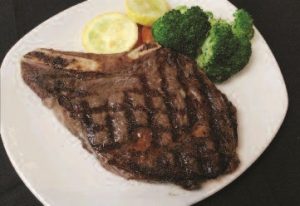 Outback Steakhouse • Bone-In Natural Cut Ribeye
Outback Steakhouse • Bone-In Natural Cut Ribeye
901 Mountain Avenue • SPRINGFIELD
(973) 467-9095 • outback.com/locations/nj/springfield
This is the entire staff’s favorite, guests rave about. Bone-in and extra marbled for maximum tenderness, juicy and savory. Seasoned and wood-fired grilled over oak.
— Duff Regan, Managing Partner
 Arirang Hibachi Steakhouse • Volcano Roll
Arirang Hibachi Steakhouse • Volcano Roll
23A Nelson Avenue • STATEN ISLAND, NY
(718) 966-9600 • partyonthegrill.com
Hot-out-of-the-oven, crab, avocado and cream cheese rolled up and topped with a mild spicy scallop salad.
 Ursino Steakhouse & Tavern • House Carved 16oz New York Strip Steak
Ursino Steakhouse & Tavern • House Carved 16oz New York Strip Steak
1075 Morris Avenue • UNION
(908) 977-9699 • ursinosteakhouse.com
Be it a sizzling filet in the steakhouse or our signature burger in the tavern upstairs, Ursino is sure to please the most selective palates. Our carefully composed menus feature fresh, seasonal ingredients and reflect the passion we put into each and every meal we serve.
 Vine Ripe Markets • Filet Crostini with Horseradish Cream Sauce
Vine Ripe Markets • Filet Crostini with Horseradish Cream Sauce
430 North Avenue East • WESTFIELD
(908) 233-2424 • vineripemarkets.com
Savory, tender, with a touch of aromatic and toasted flavors that tantalize the senses! Filet Mignon served rare and shaved onto homemade Garlic Crostini, topped with our Horseradish Cream Sauce is a medley of tender and crispy textures perfect for sharing with family and friends, any time of year!
— Frank Bruno, Chief Culinary Officer
You had what most people would consider an unconventional childhood. Looking back, what did your mom and dad get right in terms of nurturing your talent and creativity?
They were incredibly brave. My father was a musician and he was the creative side of my parents, while my mom was more analytical. She was an office manager.
So two different parenting philosophies that came together.
They loved and adored me and made me feel I could do anything in the world I wanted to do.
What were their aspirations for you?
My dad’s dream was that I might eventually join his band and that we could go on tour together. As much as I love music and have it around me—I married a musician and have musical children—I went into dancing and eventually found my way into acting. Because I was a methodical child when I went to them at 14 and said “I have a plan…I want to move to L.A. when I’m 16, do I have your blessing?” they knew I was serious and supported me. When I became a parent, I looked back. When my kids were 14 and 16, I don’t think I would have been comfortable with that.
Which of their parenting skills have you embraced?
My husband and I always encourage our kids to follow their dreams and their instincts. It’s more important for you to be happy than ”successful.” Find a career that feeds your soul and makes you feel good. That’s a thing that I definitely pulled from my childhood.
You played Shelly on Twin Peaks as a young woman and now you are back in the same role, playing the mother of a young woman. Was that unexpected?
It was definitely a surprise that she was a mother of an early-20s child, who is following in her mom’s footsteps in an abusive relationship—and also to show that Shelly hasn’t emerged from that cycle, either. It was fascinating for me to see what David Lynch and Mark Frost wrote. Shelly has to think about what advice she would give and that fine line of protecting her without pushing her too far away. It threw me at first, but that story of the cycle that didn’t break…it is an important one to tell.
In Riverdale, you’re a different type of mom.
Yet she’s a mother in a similar way to Shelly, in terms of wanting to protect her children. She just goes about it in a completely opposite manner. Shelly is trying to keep her distance and show her daughter love, whereas Alice steps in every single time. She’s completely overbearing, a bull in a china shop—but with the same good intentions.
Editor’s Note: Mark Stewart conducted this interview, which strayed into some fascinating territory after the allotted time. For 5 more minutes with Mädchen Amick log onto EdgeMagOnline.com.
To make it big in the world of situation comedy, you can’t be just another pretty face. In fact, jaw-dropping good looks often work against you. Jaime Pressly was an absolute revelation in the demented, over-the-top sitcom My Name Is Earl—giving as good as she got with comedy veterans Jason Lee and Ethan Suplee, and setting new standards for questionable parenting as Earl’s ex-wife, Joy. Now a mother herself (son Dezi is 11 and twins Leo and Lenon were born last year), Pressly has landed on yet another hit comedy series, co-starring with Alison Janney and Ana Faris in Mom. Gerry Strauss talked to Jaime about her unique upbringing, and how it has influenced her career choices.
EDGE: After your Emmy-winning performance as Joy on My Name Is Earl, the world got a chance to fall in love with you again as Jill when you joined the cast of Mom in the show’s second season. What appealed to you about the new role?
JP: Well, the first thing that was appealing was the fact that Chuck Lorre called me and said he wanted me to do it. Anytime Chuck Lorre calls you and says he wants you to do something, you’re like, “Yup, okay.” It’s kind of like if [My Name Is Earl creator] Greg Garcia were to call me and say he wants me to do something, I’m there. So the opportunity to work with him was a no-brainer for me. And to go to work with Allison Janney and Anna Faris? That was another no-brainer for me.
EDGE: Jill is in recovery. Was that interesting to you?
JP: I was excited about the role…when Chuck called, he said, “She’s a girl who’s a recovering drug addict and alcoholic.” At the beginning, we thought she was going to be bipolar. I was like, “Well that sounds interesting. Write me in, I’m down.” The writing on Mom is incredible—much like the shows, I loved when I was a kid, like Roseanne and Maude and All in the Family and Cheers and Golden Girls. All those shows weren’t afraid to end on a low note. They had drama and comedy, and the comedy came from real-life drama, which is what made it real. It wasn’t just hitting the punchline.
EDGE: As a mom yourself, how does the shooting schedule work?
JP: I just couldn’t have asked for a better opportunity. To be able to go to work and have that great schedule when I am a mom was extremely appealing. Unlike the schedule on Earl, which was tougher because it was single camera. You know, I get to come home. I get to be with my kids in the morning and at night.
EDGE: How about your own childhood, growing up in Kinston, North Carolina? I know you competed in gymnastics. Were you a competitive kid?
JP: It was a pretty idyllic childhood, I’m not going to lie. It was a tiny, tiny town, and everybody knew each other. We rode our bikes to school in kindergarten all the way through. It was safe. My mom was a dance teacher—she only retired like a year ago. I was a gymnast for 11 years but I was actually more of a dancer. I danced for like 25 years. And competitive? No. I’m only competitive with myself. Even with going on a casting call or an audition, I would talk to everybody in the room because I’m not out to cut anybody’s throat. If I get the job, great. If I don’t, good luck to you. So it has always just been about topping myself, not anybody else.
EDGE: What do you think your parents passed down to you?
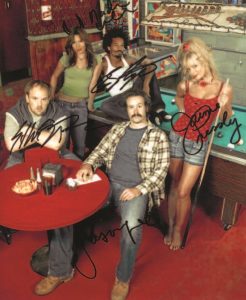
Upper Case Editorial
JP: I would say, from my mom, I learned discipline, because dancing teaches you discipline certainly. My dad would tell me that good things come to those who wait, so from him, it was more about taking things slow and learning how to be patient. With my mom, it was about learning discipline and working hard for what you get. And then manners came from both my parents because we’re southern… you know, it’s a thing there. Everything was really about manners. And with my kids, everything is about manners. My son Dezi, who’s almost 11, he’s one of the most polite children you’ll ever meet out here, I promise, in California.
EDGE: When you began your modeling career, you had to be legally emancipated from your parents’ care. How did that go down?
JP: It wasn’t a bad thing. It wasn’t like I divorced my parents. It was because neither of them could go with me, and as a teenager, I had to get past child labor laws. So we emancipated me so that I could go to Japan on the contract.
EDGE: Amicable as it may have been, you were still very young to be traveling and living on your own… across the globe, no less. Did you feel ready?
JP: I was. I had no fear. You know, really, fear never came into my body until I had a child. I was just fearless in every way. I was excited and eager to travel. It was fun for me— although I can’t imagine ever sending my child away at 15 and not going with them. But for me, it was different. I was a different kid. I grew up very quickly and I had a good head on my shoulders. I knew what I wanted, and I was a fighter. I wanted to get out there and see the world and I wanted to travel. So it never even crossed my mind to be afraid.
EDGE: When did acting enter the picture?
JP: I always wanted to act. I started out modeling first because I had entered a model search when I was back home in North Carolina. I found it in the back of a magazine, and I ended up winning. My mom and I came out here to California, and they brought us back out again because they wanted me to shoot for the cover of Teen magazine. Two other girls and I ended up getting it, and my mom and I moved out the month that my first cover came out, which was June of ’92. So that was how I got my foot in the door. But standing in front of the camera and just posing was never the plan. It was fun for a minute and I loved the travel. But it was never my end-game plan, by any means.

Chuck Lorre Productions/Warner Television
EDGE: A couple of your early roles involved some nudity and sexuality. Were you comfortable being placed in those situations?
JP: I was and I wasn’t. I mean, there were moments of me feeling like I hate doing this, but like I said, I grew up as a dancer. Dancers are very comfortable with their bodies. Also, I had a European brain back then when it came to showing your body, so I didn’t think it was that big of a deal. And then, you know, you have kids and you cover up. Overall, I didn’t love it and I can tell you that the manager that I had for many years pushed me in that direction. So it wasn’t necessarily my choice, but it was how I was managed. Whether that was right or wrong, I have my own opinions but you know, it worked.
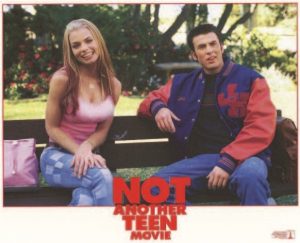
Courtesy of Original Film
EDGE: It seems as if you began to hit your stride in the teen comedies of the late-1990s—movies like Can’t Hardly Wait. How was that experience?
JP: It’s just the age that I was. We were all well out of high school. None of the people that were ever in those movies were actually teenagers. We were all adults. But those were the roles, those were the movies that were hot at the moment, and so everybody was in them.

Chuck Lorre Productions/Warner Television
Can’t Hardly Wait had everybody in it—I swear—and then Not Another Teen Movie. I mean, Chris Evans, Captain America, came out of that, you know? The roles were fun, the scripts were good and it was experience. The movies did well in the theaters, so it wasn’t like it was a bad direction to go in. And at that age, those are the roles that are offered. The older you get, the better the roles get, the more intense and deep and meaningful the roles might be. When you’re younger, you’re catering to the younger demographic and the younger demographic doesn’t exactly go out and watch heavy movies.
EDGE: Let’s talk about My Name Is Earl. You won numerous awards for your role as Earl’s ex-wife.
JP: Awards were never something on my brain. I never even imagined—I mean, every kid that wants to be an actor imagines accepting the award one day—but I never actually thought it would happen. It never occurred to me that I would even be nominated, to be honest with you. So I just was doing what I loved to do with an incredible group of people, with amazing writing that I was so fortunate to have. It was never like, a plan: I’m going to do this and go win awards.
EDGE: And of course the irony is that Joy was never meant to be a recurring character.
JP: Joy was only supposed to be in three episodes. I was given an incredible opportunity by the creator, Greg Garcia, to just kind of do my thing. After doing those three episodes, I was like, “You know, I really want to be here. I love it here, I don’t want to leave.” And so he just started writing me into all the episodes because he didn’t want me to leave, either. Thankfully. Earl was one of the greatest experiences of my life.





